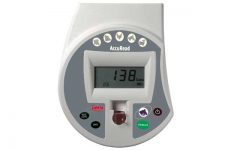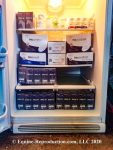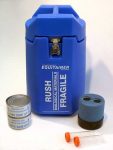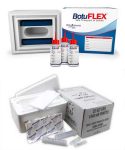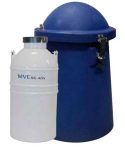The Cost of Doing Business
(or “Why do I have to pay so much for collections when I breed my mare using transported semen?”)
NOTE: Not all of the items of equipment listed are used in both the preparation of semen for either fresh or cooled use, or for freezing semen. I have therefore broken down the list into three categories – collection and use in both methods; fresh/cooled use; and frozen use. In the original article (published in 2000) pricing was in Canadian Dollars, in this updated version (2020), pricing is in US$ and should be considered approximate. To establish the working life of a piece of equipment, I am assuming moderate use – say 3 times a week throughout the breeding season.
Semen collection and initial processing:
Artificial Vagina:
This will vary in price, maintenance cost and durability depending upon what model is used. I will give an outline for what are probably the two most popular styles in North America:
The “Colorado” style will cost about $470 (or more) for a complete kit. Liners should last at least one season unless damaged accidentally, and will cost about $60 to replace. The shell is almost indestructible, and should last years.
The “Missouri” model will cost about $400 (or more) for a complete kit. It is essentially an all-latex bladder, with a leather case. Consequently, although the bladder should last multiple breeding seasons at least, if/when it does fail, one is faced with replacing essentially the whole thing.
The INRA “French” model will cost about $400. Liners should last at least one season unless damaged accidentally, and will cost about $60 to replace. The shell is almost indestructible, and should last years.
The BotuPharma “Brazilian” style will cost about $335 for a complete kit. Liners should last at least one season unless damaged accidentally, and will cost about $60 to replace. The shell is almost indestructible, and should last years.
More information about AV’s is available on the web site in our artificial vagina article.
Microscope:
Although many of the text-books describing AI will recommend a phase-contrast microscope ($3,000), a reasonable bright-field ($700) microscope will prove adequate for basic semen analysis work (motility etc.) The microscope will last indefinitely if cared for.
Semen counting device:
A variety of these are available. The cheapest, and most time-consuming is the hemacytometer ($120). Although when used properly it is very accurate and a count can be completed by an experienced technician in 10-15 minutes, if any numbers of samples are to be counted, or time is of the essence (which it often is with semen), then a mechanical device is recommended. There are several commercial machines available – including the “IMV Accuread” ($2,400, IMV International, Minneapolis, MN); the “QuickCheck” ($1,500 Exodus Breeders Corporation York, PA USA); or a Spectrophotometer, which is a basic piece of laboratory equipment that measures light transference, and which is the method that the Densimeter and IMV Accuread operate on. The “Spec. 20” is the standard model used in this field, and is priced around $2,000, however used models will be found for around $100. It should be noted that a spectrophotometer will require calibrating specifically for semen, which of course the commercial devices will already be calibrated for the purpose. Bulbs in the Spec 20 may require periodic renewal (5 or more years would be a reasonable assumption), but the rest of the equipment if cared for should last indefinitely.
Incubator or water bath:
A basic incubator is about $400 and up depending upon size, and a water bath around $300. They should last 20 years or more. A microscope slide warmer can also be very useful, and that would cost about $300, and last for a long time.
Semen Extender and Antibiotics for Extender:
Commercially prepared semen extenders are available both with and without antibiotics. Non-fat dried milk Kenney extender is the standard for the industry. Prices for that type of extender are in the region of $6.00 per 100 ml, which should be sufficient to extend one sample. INRA ’96 which a popular extender retails for around $25 for a 200 ml bottle; the “Botu” range of extenders from BotuPharma (Botusemen, Botusemen Gold, Botusemen Special and BotuTurbo) retail for between $11-14 for a 100 ml bottle. There are other cooled semen extenders available which are all around the same price, but it is essnetial to use the extender which works best for your stallion, not just go for the cheapest! Not all extenders will work with all stallions, and not all stallions will ship in all extenders, so performing a cooled semen evaluation at the beginning of every breeding season is vital to achieve the best shipments from your stallion!
Fluid Measuring Tools:
Generally the quantity of ejaculate is measured in the collection bottle (a graduated bottle such as a baby bottle), in a sterile glass or plastic graduated flask, or in a centrifuge tube. Price is negligible – a couple of dollars for a baby bottle or $15 for a glass or plastic graduated cylinder. An alternative is to weigh the collection, as 1 ml of semen weighs 1 mg. For that, one will need a scale which will be $100-150.
Thermometer:
A good thermometer is essential for measuring the AV water temperature. This will cost about $40 and should last for years.
pH measuring device:
The majority of breeding farms would not check semen pH, although it is good to do so. “Hydrion” papers are sufficient for this, and will cost under $10 for a roll that should last all season.
Dummy (or “Breeding Phantom”):
Here either a great saving or a major outlay can be made, depending upon one’s tastes and perspective!
A basic phantom, constructed of old telephone poles covered with an old mattress will cost essentially nothing if the materials are “scrounged” for. I have built probably 8 or 9 of this type of phantom and have found them to be very satisfactory in use.
A fancier phantom, with or without a built-in AV is also available. Cost of quality mounts are $3,000 and up.
Duration of phantom survival will vary with use, but 7 years at a minimum would be a conservative estimate I would think. The cover may get ripped sooner, but repair could be made easily and cheaply (often with Duct Tape!)
Some farms prefer the use of a live “jump mare”. This mare is a mare in estrus, which is receptive to a stallion’s advances. The stallion is allowed to mount the mare, and his penis is deflected into the AV, rather than being allowed to penetrate her. Some of the larger breeding operations – mostly those who are doing semen collection and analysis for outside customers – like to use an ovariectomised mare, in whom “estrus” can be induced sometimes within 4 hours or so, by the administration of a dose of estradiol. Obviously in this case, there is the cost of initial purchase and maintaining the mare for the year, plus the cost of the ovariectomy operation (upwards of $1,500 depending upon technique used); and with either the “short cycled” or ovariectomised mare, the use of hormones to induce estrus (about $10 or more per dose).
Insemination Pipette and Syringe:
Costs around $2.50 per combination.
Disposable Gloves:
$19 per box of 100 sleeves. (Note: cheaper ones are available, but tend to rip at the seams – very annoying!)
Additional equipment:
Sterile polyethylene liners for the AV. These are very convenient, as they save the necessity of cleaning the AV after each use, and considerably reduce the chance of cross-contamination if the AV is used by more than one stallion. They come in either pre-shaped liners without a built-in filter ($5 or so each) or slightly more with a filter, and in a roll for the Colorado which will yield enough liners for about 200 collections ($235).
Filters for semen:
Either specially designed filters for single-use ($9 for 10), or in-line milk filters ($13 per box of 50) can be used.
Sterile lubricant for the AV and for inseminating:
$3 per tube – a tube will last about 10 to 15 collection/insemination combinations. Alternatively as long as one is using a disposable plastic liner in the AV (which one should be!), then mineral oil can be used which costs around $2.25 a bottle and which will last for 30 or 40 collections.
Other equipment:
Once collected, the semen will need to be analyzed, and for that microscope slides ($6 per box of 72) and cover slips ($5 per box +/- 100) will be needed. If the sample is to be analyzed in a Densimeter or a spectrophotometer, then a measuring device will be required to obtain the correct quantity of semen. A pipettor, which will be accurate and allow multiple use (although one has to use a disposable tip each time – cost $40 per 1000), will cost about $300, or a single-use insulin syringe will cost about $12 per 50.
Fresh/cooled/transported semen:
Transport Containers:
Hamilton Biovet Equitainer I: $279 There are other “disposable” containers available, which cost around $35 each. The insulation tends not to be as good as the Equitainer, and they are recommended for re-use only 5 times (if not damaged) whereas we have Equitainers still safely in heavy use that are 30 years old. Although the initial outlay is greater, the cost per use is therefore considerably lower than with the disposable containers.
Shipment Packaging (the container for the semen within the Equitainer):
Most farms use a plastic baby bottle liner ($12.95 per 100) or 50 ml centrifuge tubes (under $1 each). The bottle liners are secured with rubber bands and the centrifuge tubes should have a layer of Parafilm™ – $21 per roll.
Frozen semen:
Equipment expenses associated with the actual process of freezing semen are great, and for this reason, most stallion owners that have semen frozen from their stallions elect to use the services of a business that specializes in the process (such as ourselves).
We have what I would term a good basic laboratory, and a conservative estimate of the replacement value of our equipment would be in the region of $40,000. This is a large part of the reason why the cost of freezing an ejaculate appears initially so high (we charge $395 per ejaculate, which can yield enough straws for between 5 and 15 inseminations on the average). It is important when comparing the cost of the two preservation systems though, to consider that with a healthy ejaculate the cost of the frozen semen will actually end up cheaper than the cost of a cooled insemination. This is easily calculated when you consider the average ejaculate will contain between 5 and 15 insemination doses, and if cooled semen is being used, typically only 2 or 3 insemination doses are used with the rest of the semen being discarded. With frozen semen all of the semen is used. If the cost for processing a cooled collection is $150, while a frozen ejaculate is $395, we must compare $150/2=$75 per dose vs. $395/[an average]10=$39.50 per dose – considerably cheaper! The cost of the extenders used in freezing semen varies greatly from type to type, and not all stallions freeze and thaw well, nor do they all respond in the same way to all extenders, so as you can see the variables are great with frozen semen.
For general purposes however, the majority of stallion owners would be looking at the use of cooled semen, which is covered above. Cooled semen is still much more commonly in use in North America than frozen semen.
One area where the use of frozen semen as opposed to cooled would be important is that of eliminating the need for “dual hemisphere stallions” – those that travel to the Southern Hemisphere to breed during the “off” season in the North. The use of frozen semen would eliminate that need in stallions that had semen that froze and thawed well. The successful use of cooled semen as opposed to frozen for this would be fraught with danger, as the shipment time would significantly cut into the healthy duration of viability by cooling (usually 48 to 72 hours at most). As the average farm isn’t going to be doing its own freezing, I won’t break down the costs of the freezing equipment, but would suggest if interested in freezing costs, you contact a company such as ourselves if you are in Canada or the US; or if in the UK, Stallion A.I. Services to find out freezing pricing. Note: The $395 per ejaculate we quote is for semen frozen for domestic use only. There would be other factors to consider if the semen is to be used for export, such as quarantine, tests, permits etc.
A couple of pieces of equipment that would be necessary for on-farm use of frozen semen would be a liquid nitrogen storage tank ($650) and a “vapour shipper” for sending the straws elsewhere ($1200). Storage tanks require periodic refilling with liquid nitrogen, the duration depending on the size and style of tank. We allow $600 per year per tank. The shipper costs about $80 to charge with liquid nitrogen for each use.
Minimum Equipment Necessary for a Farm offering Cooled Transported Semen:
- AV with assorted lubricants, liners, filters and thermometer. Phantom or live “jump” mare (preferably an ovariectomised mare).
- Incubator, microscope, slides and cover slips.
- Semen concentration measuring device and pipettor or syringes.
- Assorted extenders (not all stallions respond well to the same antibiotics, so a variety of 2 or 3 different extenders on hand is useful).
- A transport container such as the Equitainer.
By cutting corners with equipment, it is necessary to take excessive care in other areas. For example, we have listed an incubator as “essential equipment”, but one might be able to get by without one, but this would mean that ambient temperatures must be favourable; that semen extension must be carried our quickly; and that great attention must be paid to ensuring that the extenders are warmed in a container within a cup of water to the right temperature prior to adding to the semen. Additionally, the containers will need to be held next to one’s body to maintain body temperature. If all of these precautions are not taken, semen quality will be compromised.
A small breeding operation should be able to set up a basic serviceable cooled semen service for about $3,000 assuming that they make their own breeding mount and use a hemacytometer for sperm counting. It should be noted though, that although obviously the more equipment there is in a laboratory, the higher the cost is going to be per collection, if a farm is standing a lot of stallions, or even just a few very popular stallions, the additional equipment becomes essential as a result of the time-saving factors involved. While it may be practical for a small breeder with a stallion that breeds once per week to do all the semen counts with a hemacytometer, if doing 6 or 8 collections a day, a spectrophotometric device becomes essential!
Generally the “collection charge” that is passed on to the mare owner for each collection of semen is aimed at covering collection costs, including time. Some farms waive this charge, but commonly that is for horses with higher priced stud-fees. A typical “collection charge” in North America would be in the $150 – $250 range. We always caution mare owners that AI is not necessarily a money saver, and that using it will probably end up costing about the same as the mare going to the stallion farm to be bred. This is mainly as a result of increased veterinarian or technician charges associated with monitoring the mare’s estrus to ensure timely insemination. In some instances of course, it can be a money saver if the transportation of the mare to the stallion would entail a long journey.
© 2000, updated 2020 Equine-Reproduction.com, LLC
Use of article permitted only upon receipt of required permission and with necessary accreditation.
Please contact us for further details of article use requirements.
Other conditions may apply.


